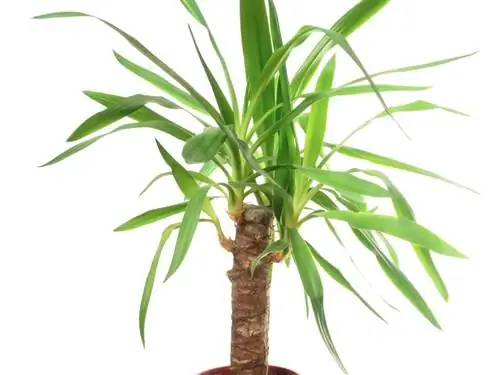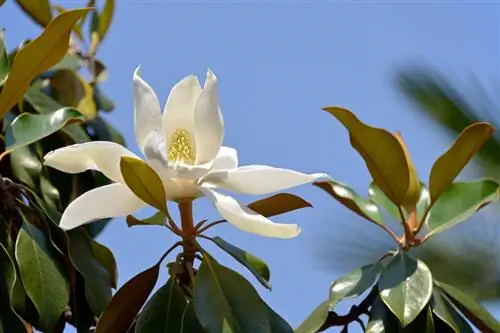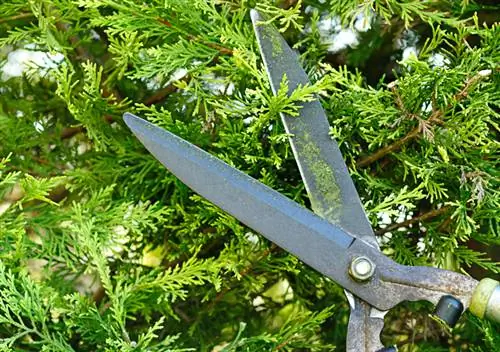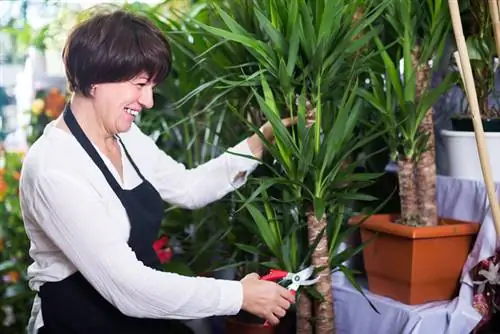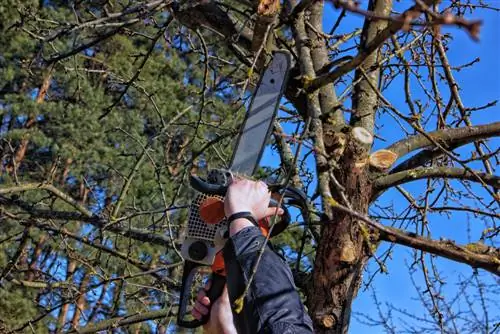- Author admin [email protected].
- Public 2023-12-16 16:46.
- Last modified 2025-06-01 06:02.
The Yucca elephantipes or giant palm lily, also known colloquially as the yucca palm, is at home in many living rooms. If the conditions are right, the plant is quite easy to care for and can grow up to five meters high even when grown in a container - so it's no wonder that many indoor gardeners occasionally have to resort to a knife.

How do I prune a yucca palm correctly?
To properly prune a yucca palm, first remove the crown and then shorten the trunk to the desired height. Seal the cuts with tree wax and plant the trunk pieces or crowns as cuttings in soil to re-root them. The best time for this is spring.
There are many reasons for pruning
If the giant palm lily is well cared for and placed in a bright and warm location, it grows surprisingly quickly and can reach the ceiling within a few years. It is understandable that the proud owner cannot avoid pruning in such a case. However, there are a few other reasons that make a cut seem sensible:
- The yucca in question grows unevenly and crookedly, so it needs to be straightened by pruning.
- The Yucca has only a few leaves and a fairly thin trunk, which is why pruning is intended to promote stronger development.
- The Yucca is sick: Spotty leaves or even a soft or hollow trunk force drastic pruning.
- A shoot of the yucca is broken or snapped off.
- A second trunk should emerge from the cut crown.
- The Yucca should be propagated using stem and shoot cuttings.
If the yucca is sick or grows sparsely, this is often an indication of inadequate cultivation conditions, for example a location that is too dark, watering too often or not fertilizing enough. In this case, the yucca should not only be cut off, but the cause of the sickly appearance should also be found out.
Cutting Yucca elephantipes - instructions
Pruning the yucca is actually quite easy, although larger specimens require a certain amount of effort. Not only should you use a fine saw (€16.00 on Amazon) to cut through the trunk, it's best to cut the trunk into several individual parts. Crowns are separated as a whole.
- First cut off the crown. A short piece of the shoot at the end of the crown should be retained.
- Now shorten the trunk to the desired height.
- If possible, divide the wood into several pieces that are at least 10 centimeters long.
- Mark on the wood where “up” and where “down” is.
- Seal the cut on the mother plant with tree wax.
- This piece should also be at least 10 centimeters long.
- The new shoots (often there are at least two, but not always) emerge directly under the cut.
- You can plant the trunk pieces and the crown(s) as cuttings in soil and re-root them.
However, you need to be patient, as it can take a few months until new shoots appear.
Tip
The best time for such a measure is spring, as the growth hormones then allow the plant to sprout again more quickly.

